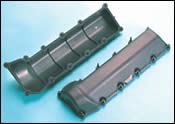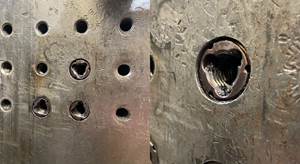Metal Replacement Accelerates In Under-Hood Parts
Plastics are making new inroads in valve covers and air-intake manifolds on U.S.-built vehicles.
Plastics are making new inroads in valve covers and air-intake manifolds on U.S.-built vehicles. In valve covers (also called rocker or cam covers), both newer glass-reinforced nylon 6 and 66 versions and the established thermoset vinyl ester composites are replacing metals by providing weight and cost savings and extended design freedom. Nylon valve covers are well accepted in Europe but were slow to catch on here before now.
In air-intake manifolds (AIMs), where glass-reinforced nylons are firmly established, new resins are appearing in specialty roles where metals previously held an edge. One is a syndiotactic polystyrene-nylon 6 blend supplied by Dow Automotive for small Russian-made vehicles. Another is polyphthalamide (PPA), a high-temperature nylon from Solvay Advanced Polymers, which is used in a high-powered engine aftermarket kit.
Doings at DaimlerChrysler
DaimlerChrysler recently adopted two innovative plastic valve covers. One is a reinforced nylon 66 cover for V-6 engines that is reportedly a first for thermoplastics in a high-volume U.S. vehicle. Also, a new valve cover for V8 engines is said to be the first in thermosets to combine straight injection molding (not injection-compression) with a thin-wall (2.5-mm) design.
The thermoplastic valve cover is molded by Bruss North America in Russell Springs, Ky. It’s a subsidiary of Germany’s Bruss AG, which pioneered nylon valve covers for Volkswagen in Europe. The cover is molded of glass/mineral-reinforced Minlon EFE6053 BK413 nylon 66 from DuPont. It replaces stamped steel in 3.3L and 3.8L valve covers for 2004 Dodge Caravan and Grand Caravan SUVs, which amount to some 500,000 units a year.
Pat Granowicz, DuPont’s engine-cover specialist, says the plastic cover achieves 65% weight savings and incorporates the air-oil separator, thereby cutting oil loss and boosting engine efficiency. The positive crankcase ventilation valve, usually bolted on the cover’s exterior, is now vibration welded inside, insulating the valve and improving start-up.
Bruss designed the V-6 valve cover in two banks of three cylinders, so the panel is smaller than a typical V-4 cover and has a modest (175 mm) bolt width. That minimizes danger of creep at elevated temperature along the cover-gasket perimeter and neutralizes a potential source of leakage, claims Michael Cuneo, Bruss’ director of program management.
Major cost savings are realized from the integrated design and reduced tool and material cost. The molded-in black color and grain texture also dispense with E-coating and painting.
In response to North America’s new interest in nylon valve covers, Rhodia is introducing grades already proven in Europe, where the firm supplies 30 valve-cover programs. “We expect three advanced programs under way in the U.S. to surface in 2005-2006 vehicles,” says Axel Zschau, Rhodia’s under-hood automotive specialist. Technyl A218 MZ15 V25 is a black nylon 66 tailored for valve covers. It contains 15% mineral and 25% glass and is said to have excellent surface appearance and superior warpage resistance and sound-damping properties, compared with nylons reinforced with glass alone.
Rhodia has led the use of acoustic analysis to optimize under-hood materials selection. It has introduced to the U.S. a pair of acoustic grades of its enhanced-flow nylon 6 for engine and timing-belt covers.
Bayer Polymers, a long-time supplier of glass-reinforced nylon 6 and 66 for valve covers in Europe, has begun to offer its materials in the U.S. Bayer sees U.S. resistance to thermoplastic covers to be gradually eroding, in part because of the emergence of improved gaskets and new techniques for enhancing noise and vibration characteristics of thermoplastics.
Composites gain strength
Meanwhile, suppliers of thermosets are expanding their 20% stake in North American valve covers by exploiting advances in BMC materials. DaimlerChrysler’s latest initiative in this arena is a large (46 in. long) 4.7L valve cover for V-8 engines in 2004 Durango and Jeep Grand Cherokee SUVs, as well as several pick-up trucks. The composite cover, which replaces magnesium, is molded by Dana Corp.’s Sealing Div. in Paris, Tenn. Volumes exceed half a million units per year. The material is a 20%-glass, vinyl ester TMC (“thick molding compound,” a variant of BMC) from Premix. A Premix source says TMC differs from BMC in having a 3D matrix of longer (1-in.) glass fibers, which retains mechanical properties better at temperatures up to 450 F. “TMC provides 30% higher mechanical strength than conventional BMC under extreme thermal-cycling conditions,” says Steve McCormack, Premix automotive business-development manager. That translates into parts with 2.5-mm walls vs. a typical 4 mm for previous BMC covers.
TMC brings additional benefits, including sound damping (by 1 to 2 db). And the plastic cover uses press-in-place gaskets instead of adhesive-bonded versions that generate volatile emissions. TMC’s high stiffness eliminates the extensive ribbing used in nylon covers to ensure leak resistance.
“This conversion realized savings of about $10 per part, representing our biggest cost-reduction success in powertrain applications for the year,” says Steve Crawford, the DaimlerChrysler program leader. He cites cost reductions of 20% in material and up to 50% in tooling vs. metal, plus additional savings from eliminating prototype tooling. That omission was made possible by computer simulation of mold flow and fiber orientation performed by the Madison Group using its Cadpress software.
Premix plans to extend use of thermosets further by replacing aluminum valve covers with SMC in General Motors’ in-line V-4, 3.7L engines for Chevrolet pick-ups.
Meanwhile, Bulk Molding Compounds, Inc. (BMCI) reports that it has three emerging BMC valve-cover programs for high-volume U.S. vehicles. One of them will be an injection molded cover for a 2005 model. BMCI officials say improved BMCs now can bridge the cost gap vs. thermoplastic covers while also offering superior durability.
New materials in AIMs
Glass-reinforced nylons dominate AIM assemblies in Europe (65% share) and have a 50% share in the U.S. But other thermoplastics are gaining traction. Examples are manifolds for 1.5L and 1.6L engines of small Lada cars made by Avtovaz in Russia. This OEM recently replaced aluminum AIMs with injection molded designs of Dow Automotive’s Questra N WA9735-01, a 35% glass-reinforced blend of nylon 66 and syndiotactic PS (SPS).
“Nylon-SPS blends have potential in AIMs, valve covers, and decorative engine covers,” says Jim Cederstrom, Dow Automotive market-development manager for air induction. Questra N blends incorporate nylon 6, 66, or 6/66 combinations as the continuous phase, thereby retaining nylon’s processability and surface appearance. The dispersed SPS phase reduces moisture pick-up to enhance dimensional stability and warp resistance. SPS also boosts mechanical-property retention at under-hood temperatures.
Questra N in Avtovaz AIMs yields weight and cost savings of 50% and 30% respectively, mostly due to parts integration. The twin shells of the AIM module are joined by vibration welding, but Dow Automotive foresees future cost benefits by using its proprietary adhesives.
Another new material in AIMs is Solvay’s Amodel A-6135, a 35%-glass polyphthalamide (PPA) that replaces aluminum in a high-torque, supercharged OEM aftermarket kit for General Motors’ LS engine. This AIM was introduced by Fuel-Air-Spark Technologies in Ashland, Miss., for V8 and V6 engines of the Corvette, Camaro, and Pontiac Firebird.
Amodel provides 1.65 million psi flexural modulus, higher heat resistance than nylon 66, and creep resistance at elevated temperature equal to that of aluminum. PPA reportedly also offers outstanding resistance to engine oils, grease, and long-life coolants. The three-piece assembly, made by Composite Performance Technologies in Rochester Hills, Mich., weighs 11 lb vs. 26-lb for aluminum. The smoother PPA inner surface also improves the AIM’s air-flow rate by 25% and horsepower rating by 6%.
Related Content
PEEK for Monolayer E-Motor Magnet Wire Insulation
Solvay’s KetaSpire KT-857 PEEK extrusion compound eliminates adhesion and sustainability constraints of conventional PEEK or enamel insulation processes.
Read MoreCelanese to ‘Shine’ at CES 2023 with Expanded Portfolio of Materials
With it acquisition of DuPont’s engineering resins, Celanese’s resin solutions for automotive electrification, e-mobility and consumer electronics are plentiful.
Read MoreAutomotive Awards Highlight ‘Firsts,’ Emerging Technologies
Annual SPE event recognizes sustainability as a major theme.
Read MoreMolder Repairs Platen Holes with Threaded Inserts
Automotive molder ITW Deltar Fasteners found new life for the battered bolt holes on its machine platens with a solution that’s designed to last.
Read MoreRead Next
Beyond Prototypes: 8 Ways the Plastics Industry Is Using 3D Printing
Plastics processors are finding applications for 3D printing around the plant and across the supply chain. Here are 8 examples to look for at NPE2024.
Read MorePeople 4.0 – How to Get Buy-In from Your Staff for Industry 4.0 Systems
Implementing a production monitoring system as the foundation of a ‘smart factory’ is about integrating people with new technology as much as it is about integrating machines and computers. Here are tips from a company that has gone through the process.
Read More














